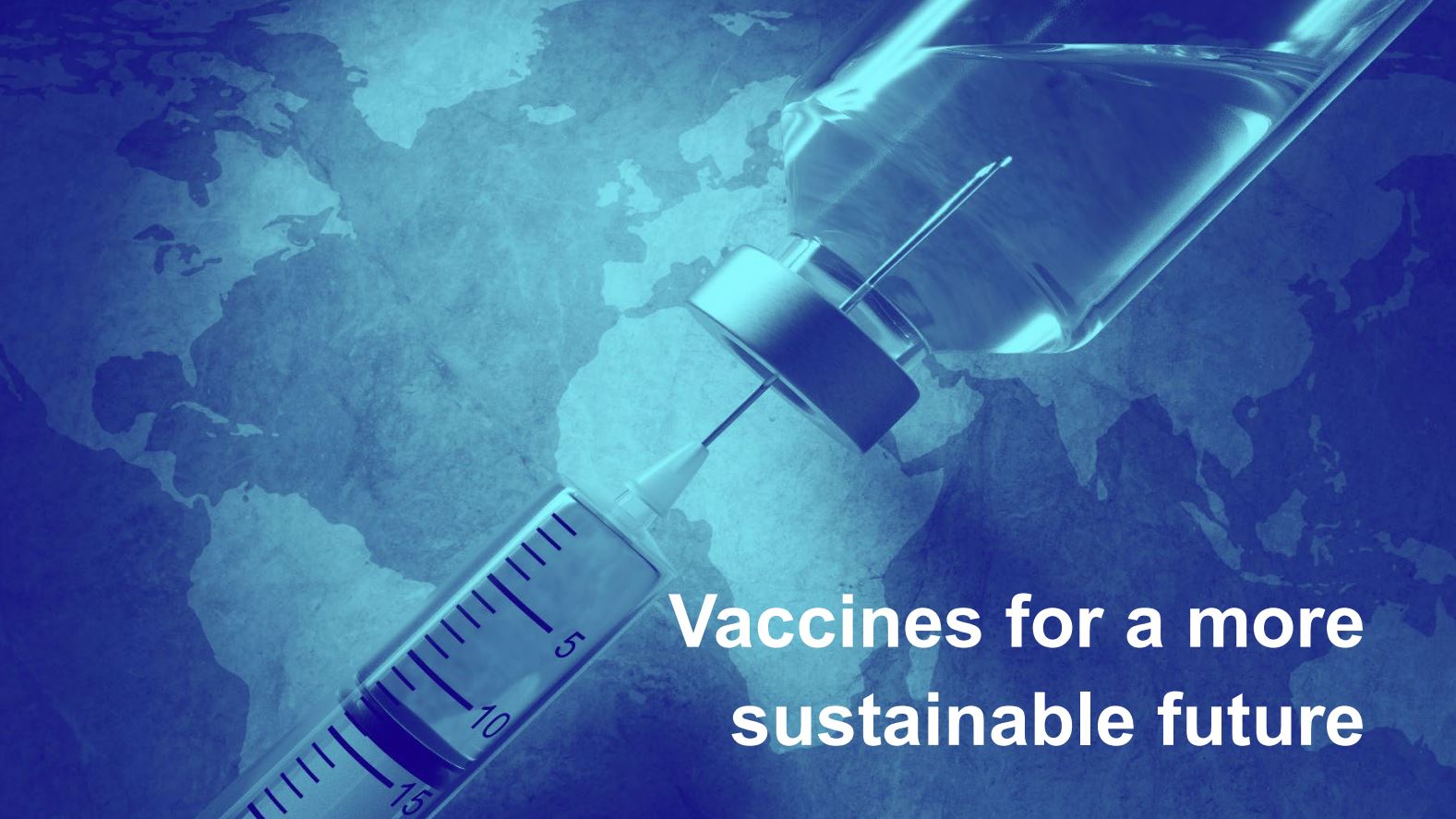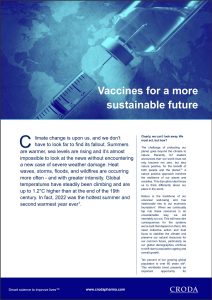Vaccines for a more sustainable future

Climate change is upon us, and we don’t have to look far to find its fallout. Summers are warmer, sea levels are rising and it’s almost impossible to look at the news without encountering a new case of severe weather damage. Heat waves, storms, floods, and wildfires are occurring more often – and with greater intensity. Global temperatures have steadily been climbing and are up to 1.2°C higher than at the end of the 19th century. In fact, 2022 was the hottest summer and second warmest year ever1.
Clearly, we can’t look away. We must act, but how?
The challenge of protecting our planet goes beyond the climate to nature. Recently, G7 leaders announced that “our world must not only become net zero, but also nature positive, for the benefit ofboth people and the planet.2” A nature positive approach enriches the resilience of our planet and societies. This disruptive idea forces us to think differently about our place in the world.
Nature is the backbone of our universal well-being and has inextricable ties to our economic foundation3. When we continually tap into these resources in an unsustainable way, we will inevitably run out. This will have dire consequences for the systems we’ve built that depend on them. We need collective action and dual focus to stabilise the climate and preserve our natural resources for our common future, particularly as our global demographics continue to shift due to population ageing and overall growth.
Ten percent of our growing global population is over 60 years old4. This worldwide trend presents an important opportunity for sustainable development. The changing landscape of our society relies on active participation from older generations. We must prepare for the social and economic transformations associated with ageing, developing the necessary conditions to enable these generations to lead self-determined, healthy lives. For this, we rely on fundamental shifts in policy and universal attitudes to older persons and their part in society. Luckily, the global community is reacting.
Recognising the need for dramatic change to slow this trajectory, the United Nations adopted 17 Sustainable Development Goals (SDGs) in 2015, as a universal call to protect the planet, end poverty and ensure that all humans enjoy peace and prosperity by 20305. The 17 SDGs are interlinked,emphasising the importance of addressing them all.
The third UN SDG describes how good health is pivotal to sustainable development. As the global population continues to rise, and as we’re all living longer, it’s important to ensure good health continues in our later years. Preventative care is one of the best ways to support this reality. A continual threat is the burden of infectious diseases: millions of lives are lost to diseases that are largely preventable. Global immunisation is the key. That’s where vaccines get to work. Vaccines are not only protecting us from direct pathogens, but also paving the way for a more sustainable future.
How vaccines promote planetary health and sustainability
Major historical events have evidenced the criticality and importance of vaccines for global health. Vaccines have helped prevent cervical cancer in women, as well as reduce pneumococcal and meningococcal diseases in children, and edge us closer to eradicating polio. Since 1988, the number of children affected by polio has reduced by 99 percent6 . Thanks to the measles vaccine alone, 23 million deaths were averted between 2010 and 20187.
Meanwhile, more recently, the significance of vaccines was crystallised during the COVID-19 pandemic, whereby vaccines averted 20 million deaths, saved the global economy trillions, and helped restore free movement in society8.
Vaccination has enabled us to prevent over 20 life-threatening diseases. This means more people are living longer, healthier lives.
However, political, economic, and cultural hurdles have meant that many are losing out on vaccinations. In 2020, 22.7 million children missed basic vaccines – almost 4 million more than the year before9. Much of this is attributed to the repercussions of the pandemic, with countries falling backwards on other vaccinations. Not only does this widen the inequalities in vaccine access, but it also leaves certain populations more vulnerable to future threats. For instance, WHO reported that only 82% are now fully vaccinated against DTP (diphtheria, tetanus, and pertussis) in the Americas, down from 91% in 201610.
The types of vaccines we use are equally important as our access to them. Sustainable vaccine development relies on access to a diverse, strong range of technologies such as liveattenuated, inactivated, subunit, and RNA-based vaccines. In this way, we can create new vaccines that tackle different antigens and diseases, protecting even more people against conditions that can otherwise be very difficult to treat. Still, there’s another piece of the puzzle. Vaccine development is a complicated, time-intensive process. Once a winning formula is made – and passes through the various intensive stages of clinical approval – it’s important to ensure it continues to be available and isn’t delisted due to the lack of commercially available sustainable ingredients. This is why designing vaccines using sustainable ingredients is critical. Sudden surges in demand could quickly lead to shortages, bringing consequences that would derail our vaccine access a decade or two from now. Given the long development pipelines waiting until then to find sustainable alternatives will be too late. Vaccines are a key tool for protecting the planet and meeting our sustainability goals. The responsibility is on us all to not only select sustainable ingredients, but to secure supply chains and sources that will not deplete in the future. It’s therefore essential that our efforts are prioritised, to help ensure that everyone gets the vaccines they need.
Emerging technologies
Key formulation ingredients increase the likelihood of vaccine success. For example, modern vaccines often incorporate adjuvants and adjuvant systems, which are ingredients that are used to help induce a stronger immune response. Adjuvants can amplify vaccine efficacy by helping to raise an early, long-lasting, and efficient immune response to a vaccine. In turn, this can provide significant protection against the disease being targeted. When combined with immunostimulatory molecules, the resulting adjuvant systems can help reach the same level of immune protection with fewer injections or a lower dose than when vaccinating with the non-adjuvanted antigen alone. Adjuvant systems stimulate immunity at various stages of the immune response, for instance, by activating chemokine signalling and targeting specific types of immune cells, such as dendritic cells and Thelper cells (typically Th1, Th2, or others).
However, some vaccine formulations do not result in optimal antigen delivery and presentation, reducing vaccine efficacy as a result. Thus, a diverse repertoire of adjuvant systems is necessary to create better vaccines. Modern vaccine development is focusing on discovering and incorporating new adjuvants to help address those countless conditions without current vaccine solutions. Establishing new adjuvants empowers us to achieve new pathways of immunisation that unlock new therapies – and therefore help even more people. As ongoing research continues to establish a more extensive portfolio of adjuvant system technologies, this enables us to not only address
more diseases, but helps us also potentially improve the efficacy of existing vaccines.
Aluminium salts are the most wellknown and widely used class of adjuvants. Generally referring to aluminium phosphate and aluminium hydroxide, they adsorb the protein antigen and mediate its presentation to innate immune cells11,12. Certain oil-in-water emulsions (eg. MF59 and AS03) mediate local inflammatory responses13. Saponin based adjuvant systems, including MatrixM and QS 21, offer multiple effects that support humoral and cellular immune responses14. Certain components such as squalene are used in combination with surfactants in specific adjuvant formulations. Meanwhile, neoantigen vaccines that tackle cancer are being explored as therapeutic vaccines using the CAF family of adjuvants, such as CAF09b.
Scientists and vaccine manufacturers are continuously innovating to expand the repertoire of available adjuvant options. While we work to discover novel adjuvant formulations, we must use existing options responsibly. The SBTN
(science-based targets for nature) high impact commodity list has highlighted the need for more awareness around the material impact on nature of certain supply chains. The use of raw materials derived from these commodities as key ingredients in vaccines will, in the future, need to be better understood and managed by raw material suppliers, adjuvantproducers, and vaccine developers.
Beyond this, as we’ll share below, the use of some of the most prominent and promising components, saponins and
squalene, has been affected by other sourcing challenges – once again highlighting the need for sustainable supplies.
Download the full whitepaper “Vaccines for a more sustainable future” here:
(click the picture below)
Source: Croda, White Paper Vaccines for a more sustainable future, website Sugar-derived squalene | Croda Pharma
Request a sample or more information here:
Read more on “Excipients for Parenterals” here:



